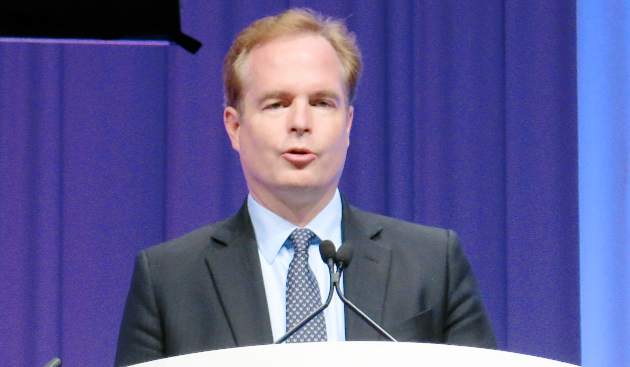User login
WASHINGTON– The oral S1P receptor modulator ozanimod is clinically active and well tolerated in patients with moderate to severe ulcerative colitis (UC), phase II study results show.
Importantly, no notable cardiac, opthalmologic, or infectious treatment-related adverse events were observed, Dr. William Sandborn said at the annual Digestive Disease Week.
The first sphingosine-1-phosphate (S1P) receptor modulator, Fingolimod (Gilenya), carries a warning for first-dose cardiac effects, liver function test elevations, and macular edema and targets S1P receptors 1, 3, 4, and 5. Ozanimod is a next-generation S1P receptor modulator that has increased selectivity for the S1P receptors 1 and 5, compared with receptor 3, which may be related to safety concerns with fingolimod, said Dr. Sandborn, chief of gastroenterology at the University of California-San Diego.
He reported on the double-blind, phase II TOUCHSTONE trial involving 197 adults with moderate to severe UC who were receiving oral aminosalicylates and/or prednisone, and were randomly assigned to receive ozanimod 0.5 mg (n = 65) or 1 mg (n = 67) or placebo (n = 65). Doses were titrated through week 1, followed by 8 weeks of full-dose therapy.
The study’s primary efficacy endpoint was the proportion of patients in clinical remission at week 8, defined as a Mayo score of 2 or less, with no subscore of more than 1.
At week 8, 16.4% of patients on ozanimod 1 mg were in remission vs. 6.2% on placebo (P = .0482) and 13.8% on ozanimod 0.5 mg (P = .1422), Dr. Sandborn reported.
Rates of clinical response at 8 weeks were 56.7% with the high-dose ozanimod, 53.8% with the low dose, and 37% with placebo. Once again, the between-group difference was significant only for high-dose ozanimod (P = .0207).
Mucosal improvement was significantly more common with either high-dose ozanimod (34.3% vs. 12.3% placebo; P = .0023) or low-dose ozanimod (27.7% vs. 12.3% placebo; P = .0348), he said.
The most common adverse events were anemia/decreased hemoglobin, occurring in four patients in the placebo and low-dose ozanimod groups, and worsening of UC, occurring in three patients on placebo, two on low-dose ozanimod, and one on high-dose ozanimod.
Serious treatment-related adverse events were reported in four patients on placebo, one on ozanimod 0.5 mg (hyperpyrexia), and one on ozanimod 1 mg (UC).
The overall incidence of cardiac events was low, with two palpitations reported in the placebo group, one sinus bradycardia and one first-degree AV block in the ozanimod 0.5-mg group, and none in the 1-mg group.
“Ozanimod was well tolerated with a favorable benefit-risk profile supporting the planned phase III trial in ulcerative colitis and the phase II study in Crohn’s disease,” said Dr. Sandborn, who also reported the results earlier this year in Europe.
On Twitter@pwendl
WASHINGTON– The oral S1P receptor modulator ozanimod is clinically active and well tolerated in patients with moderate to severe ulcerative colitis (UC), phase II study results show.
Importantly, no notable cardiac, opthalmologic, or infectious treatment-related adverse events were observed, Dr. William Sandborn said at the annual Digestive Disease Week.
The first sphingosine-1-phosphate (S1P) receptor modulator, Fingolimod (Gilenya), carries a warning for first-dose cardiac effects, liver function test elevations, and macular edema and targets S1P receptors 1, 3, 4, and 5. Ozanimod is a next-generation S1P receptor modulator that has increased selectivity for the S1P receptors 1 and 5, compared with receptor 3, which may be related to safety concerns with fingolimod, said Dr. Sandborn, chief of gastroenterology at the University of California-San Diego.
He reported on the double-blind, phase II TOUCHSTONE trial involving 197 adults with moderate to severe UC who were receiving oral aminosalicylates and/or prednisone, and were randomly assigned to receive ozanimod 0.5 mg (n = 65) or 1 mg (n = 67) or placebo (n = 65). Doses were titrated through week 1, followed by 8 weeks of full-dose therapy.
The study’s primary efficacy endpoint was the proportion of patients in clinical remission at week 8, defined as a Mayo score of 2 or less, with no subscore of more than 1.
At week 8, 16.4% of patients on ozanimod 1 mg were in remission vs. 6.2% on placebo (P = .0482) and 13.8% on ozanimod 0.5 mg (P = .1422), Dr. Sandborn reported.
Rates of clinical response at 8 weeks were 56.7% with the high-dose ozanimod, 53.8% with the low dose, and 37% with placebo. Once again, the between-group difference was significant only for high-dose ozanimod (P = .0207).
Mucosal improvement was significantly more common with either high-dose ozanimod (34.3% vs. 12.3% placebo; P = .0023) or low-dose ozanimod (27.7% vs. 12.3% placebo; P = .0348), he said.
The most common adverse events were anemia/decreased hemoglobin, occurring in four patients in the placebo and low-dose ozanimod groups, and worsening of UC, occurring in three patients on placebo, two on low-dose ozanimod, and one on high-dose ozanimod.
Serious treatment-related adverse events were reported in four patients on placebo, one on ozanimod 0.5 mg (hyperpyrexia), and one on ozanimod 1 mg (UC).
The overall incidence of cardiac events was low, with two palpitations reported in the placebo group, one sinus bradycardia and one first-degree AV block in the ozanimod 0.5-mg group, and none in the 1-mg group.
“Ozanimod was well tolerated with a favorable benefit-risk profile supporting the planned phase III trial in ulcerative colitis and the phase II study in Crohn’s disease,” said Dr. Sandborn, who also reported the results earlier this year in Europe.
On Twitter@pwendl
WASHINGTON– The oral S1P receptor modulator ozanimod is clinically active and well tolerated in patients with moderate to severe ulcerative colitis (UC), phase II study results show.
Importantly, no notable cardiac, opthalmologic, or infectious treatment-related adverse events were observed, Dr. William Sandborn said at the annual Digestive Disease Week.
The first sphingosine-1-phosphate (S1P) receptor modulator, Fingolimod (Gilenya), carries a warning for first-dose cardiac effects, liver function test elevations, and macular edema and targets S1P receptors 1, 3, 4, and 5. Ozanimod is a next-generation S1P receptor modulator that has increased selectivity for the S1P receptors 1 and 5, compared with receptor 3, which may be related to safety concerns with fingolimod, said Dr. Sandborn, chief of gastroenterology at the University of California-San Diego.
He reported on the double-blind, phase II TOUCHSTONE trial involving 197 adults with moderate to severe UC who were receiving oral aminosalicylates and/or prednisone, and were randomly assigned to receive ozanimod 0.5 mg (n = 65) or 1 mg (n = 67) or placebo (n = 65). Doses were titrated through week 1, followed by 8 weeks of full-dose therapy.
The study’s primary efficacy endpoint was the proportion of patients in clinical remission at week 8, defined as a Mayo score of 2 or less, with no subscore of more than 1.
At week 8, 16.4% of patients on ozanimod 1 mg were in remission vs. 6.2% on placebo (P = .0482) and 13.8% on ozanimod 0.5 mg (P = .1422), Dr. Sandborn reported.
Rates of clinical response at 8 weeks were 56.7% with the high-dose ozanimod, 53.8% with the low dose, and 37% with placebo. Once again, the between-group difference was significant only for high-dose ozanimod (P = .0207).
Mucosal improvement was significantly more common with either high-dose ozanimod (34.3% vs. 12.3% placebo; P = .0023) or low-dose ozanimod (27.7% vs. 12.3% placebo; P = .0348), he said.
The most common adverse events were anemia/decreased hemoglobin, occurring in four patients in the placebo and low-dose ozanimod groups, and worsening of UC, occurring in three patients on placebo, two on low-dose ozanimod, and one on high-dose ozanimod.
Serious treatment-related adverse events were reported in four patients on placebo, one on ozanimod 0.5 mg (hyperpyrexia), and one on ozanimod 1 mg (UC).
The overall incidence of cardiac events was low, with two palpitations reported in the placebo group, one sinus bradycardia and one first-degree AV block in the ozanimod 0.5-mg group, and none in the 1-mg group.
“Ozanimod was well tolerated with a favorable benefit-risk profile supporting the planned phase III trial in ulcerative colitis and the phase II study in Crohn’s disease,” said Dr. Sandborn, who also reported the results earlier this year in Europe.
On Twitter@pwendl
AT DDW 2015
Key clinical point: Ozanimod 1 mg induced clinical remission at week 8 in patients with moderate to severe ulcerative colitis.
Major finding: At week 8, 16.4% of patients on ozanimod 1 mg were in remission vs. 6.2% on placebo (P = .0482) and 13.8% on ozanimod 0.5 mg (P = .1422).
Data source: Randomized, double-blind trial of 197 patients with moderate to severe ulcerative colitis.
Disclosures: Dr. Sandborn reported financial relationships with numerous firms including Receptos, which funded the study.

